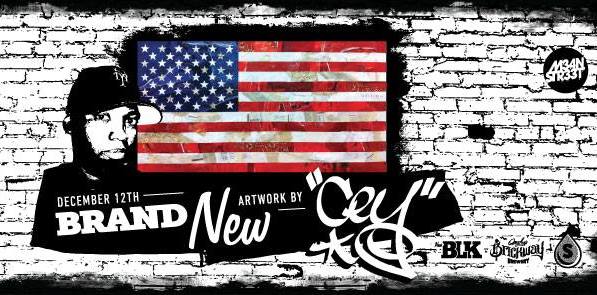Searching for the pinnacle of “clean design” has always coaxed Cey Adams backward in time.
Even when Adams was the founding creative director at Def Jam Records in the late ‘80s and early ‘90s, designing for artists like LL Cool J, Run DMC and more, he looked to ‘60s pop art —not necessarily the work of his contemporaries — for cues.
“Not to name any names, but I’m talking about the bling era,” Adams says. “Photoshop-driven design was just dreadful. I thought, ‘Oh, my goodness, this is gonna be our legacy.’ I wanted to separate the work I was doing from the pack, and that was going back to classics and looking at stuff from the Blue Note era.”
His connections to design classicism, graffiti art and painting helped usher in Adams’ longevity, and led him to Omaha earlier this year for a residency at Bemis Center for Contemporary Arts. And then back to Nebraska again for an exhibition tonight at The New Blk.
“Brand New” is curated by Sweatshop Gallery’s Kim Reid Kuhn, and features musical performances from M34N STR33T and Dojorok. Adams’ work will remain on display and viewable by appointment through Jan. 15, 2015.
Adams describes this collection as “labor intensive,” all paper and handmade renderings of deconstructed and reconstructed images from the populist brands Adams grew up with: Coke, Pepsi, Adidas, Nike and others. In that way, it’s a celebration of American graphic design’s greatest hits, those images that have become so ubiquitous that Adams says people may actually need to be reminded that they came from a designer with a vision.
“We’re hit over the head with the term ‘brand’ so much now that the imagery is an afterthought,” he says.
As a career graphic designer, Adams acknowledges the complexity of corporate iconography, but the centerpiece of “Brand New” might be the most evocative, multi-layered symbol of the bunch. Especially given the social and racial turmoil over which it currently flies.
“The American flag is the number one brand in America,” Adams says of the piece. “It sounds kind of hokey, but it really is true.”
Though Adams had never been to Omaha prior to this residency at Bemis this past summer, he says he found the people friendly and the artists eager to collaborate. October marked the reveal of a North Omaha mural he worked on with artists Dereck Higgins, Ben Jones, Aaryon Williams and Olivia Groth.
“All the local artists I met here were really eager to make sure I left with a clear understanding of what it’s like to live and work in Omaha,” Adams says. “It was something that really moved me. I couldn’t wait to get an opportunity to show them the work I was doing.”
Growing up in Queens and coming to professional promise in New York City, Adams had a frontrow seat to watch some of hip-hop’s most influential trailblazers make their first imprints on the culture. Before they were stars, this happened at a local level.
He says that’s why it’s crucial for a city like Omaha to support musicians like M34N STR33T — who will perform at 10 p.m. tonight — and why it’s rewarding for him to dialogue with the next generation of musicians and artists.
“The thing I really have to emphasize is that I dig being a part of what [M34N STR33T] is doing,” he says. “As much as they’re connected to history through me, I’m connected to [what will be our] history through them. Just because I’ve done design for all these iconic bands doesn’t mean every kid who grabs a microphone or paintbrush knows who I am.”
Like Janette Beckman — the storied hip-hop photographer who was at Bemis in the early fall (and with whom Adams collaborated this year) — the timeliness and success of his past work, and his willingness to share it now, affords him a unique position to pursue collaborations and residencies in places like Omaha. From the outside, a New York artist returning to Omaha on a whim this winter may seem surprising. For Adams, it’s not philosophically out of the ordinary.
“I’m at a point in my career where I don’t force it,” he says. “If someone is doing really interesting work and people are proactive in the community, that’s what I want to support. That’s really my incentive for coming back. If my history can get a young kid to think about his future in a way he hadn’t before I got to town … I’m very happy to come here as many times as they’ll have me.”




